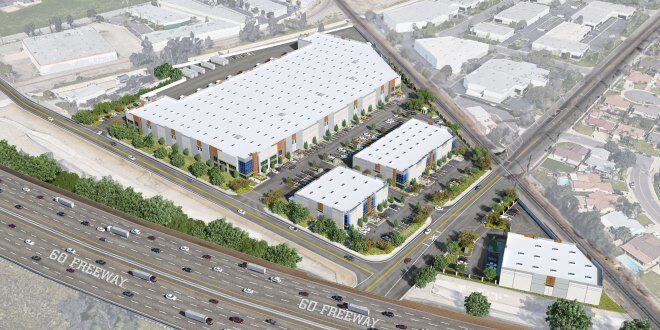Yes, the local industrial sector remains a juggernaut, but there could be some issues, starting with the supply-chain disruption, that could slow things down.
As 2022 approaches, is the Inland Empire industrial market about to experience a slowdown?
The answer to that question might be yes, at least on one side of the equation, according to one of the region’s most experienced brokers of warehouse-distribution properties.
“I’m not seeing a slowdown on the demand side, because there will continue to be a demand for industrial space in the Inland Empire,” said Paul Earnhart, senior vice president with Lee & Associates Ontario. “Where I’m seeing the problem is on the supply side. We’re running out of space, especially space that can handle larger projects.”
By “larger projects” Earnhart means 500,000 square feet and up, commonly known as “big-box” development. Industrial projects that size have for years flourished on the west end, particularly around Ontario International Airport, but now developers are starting to look to the High Desert when they need to build something that large.
That trend is only going to get stronger, according to Earnhart.
The east end will continue to get its share of industrial development, but much of that will end up in the World Logistics Center, the 2,600-acre warehouse-distribution project planned for Moreno Valley, Earnhart said.
Construction has not begun on that project, potentially one of the largest logistics developments in the world. Plans call for the World Logistics Center to have more than 40 million square feet of logistics space when it’s completed.
But finding space on the west end is going to be more and more difficult, and that could slow down absorption until the market adjusts.
“It’s going to be like musical chairs,” said Earnhart, who said he’s only predicting a possible mild slowdown in the next 12 months, not anything severe.. “People looking for enough land are going to be looking for chairs, but there won’t be enough chairs to go around.”
Another factor that might help slow the Inland industrial market in 2022 is the growing opposition to the building of more big-box industrial projects, which opponents say bring traffic, noise and air pollution to their communities.
That opposition has taken two forms: neighborhood groups that want to keep those mega-developments away from residential neighborhoods and schools, and government agencies trying to curb those projects with more regulations, like the South Coast Air Quality Management District requiring trucks to change from diesel to electric engines.
“I’m sure there are some communities that have had to deal with some problems, but a lot of the opposition that we’re getting now is political,” Earnhart said. “The Inland Empire has always been pro-development, but now it’s moving in the other direction, and that could slow things down. The next couple of years are going to be interesting.”
Despite all of that, demand for space will still be high, enough to drive up lease rates to as much as $1.25 a square foot, about 25 cents higher than they are now, Earnhart predicted.
The Inland industrial market, which got a huge boost from the increase in online shopping created by COVID-19, just finished one of its strongest quarters ever, with 21.3 million square feet of industrial space under construction when the quarter ended.
At the end of the third quarter, the industrial vacancy rate in Riverside and San Bernardino counties was 0.7 percent, the lowest in the region’s history, according to CBRE’s third quarter report on the Inland industrial market.
Average lease rates were 91 cents per square foot, a 51.7 percent increase year-over-year, and gross activity from January through September topped 39 million square feet, potentially setting up a record-breaking year, CBRE reported.
One of the biggest issues facing the Inland Empire is the interruption of the global supply chain caused by COVID-19, said Chuck Belden, vice chairman with Cushman & Wakefield Ontario and a broker of “big-box” industrial development.
“I’m watching this and I can’t quite figure it out,” Belden said of the supply chain disruption, which has cargo ships waiting for weeks to get unloaded at the ports of Los Angeles and Long Beach. “All I know it’s a serious issue for the Inland Empire, because so much of what is shipped here comes from Asia.”
As for 2022, Belden predicted lease rates will probably go up slightly but that vacancy probably will stay where it is now because the demand for storage space in the two-county region will remain high.
“I’ve been doing this for 38 years and I’ve never seen demand like it is now,” Belden said. “Not not only the Inland Empire but all of Southern California, and I don’t see that changing next year.”
 IE Business Daily Business news for the Inland Empire.
IE Business Daily Business news for the Inland Empire.


